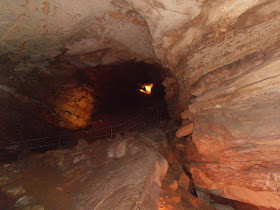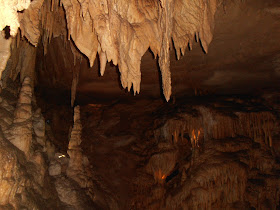Historic Tour
Our tour guide for the Historic Tour was Ranger Eric. Ranger Amanda followed the group to ensure we all stayed together. Although the tour limit is 120, we only had 46 people. Since the cave is out of the weather and at a constant 54 degrees Fahrenheit, any season is a good time to visit. Unless you have school-age children, there is no need to endure the summer crowds. The tour starts by walking down the road from the visitor center to the natural or historic entrance to the cave. Tours have been offered via this entrance since 1816. Once near the entrance, we had a safety briefing and descended a set of about 100 stairs into the cave. A steel structure has been erected inside the cave to control human visitation, but still allow air to flow in or out of the cave. |
| Entrance Stairs |
 |
| Ruins of saltpeter mining in the Rotunda |
 |
| Giant's Coffin |
 |
| Bottomless Pit |
 |
| Fat Man's Misery |
 |
| Historic Graffiti |
 |
| Flowstone in Mammoth Dome |
 |
| Stair Tower |
 |
| Mammoth Dome from the Stair Tower |
At the top of the stairs, we entered a passageway called Little Bat Avenue that led back to the Rotunda and then out the Main Cave to the historic entrance.
 |
| The Rotunda...again |
 |
| Daylight! |
Surface Trails
Between cave tours, we drove back out the Cave City Road to the entrance sign and strolled along the 0.1 mile Sand Cave Trail elevated boardwalk. This pleasant walk has several interpretive signs to commemorate the failed rescue attempt of Floyd Collins in 1925. |
| Sand Cave Boardwalk |
 |
| Sand Cave |
 |
| View down the Green River valley from Sunset Point |
New Entrance Tour
This tour requires a short bus ride going and coming. From the drop off point, we walked down into the sinkhole and then through a door into a short tunnel used as an airlock. After going through the second door, we had the opportunity to peer down into the vertical shaft, or pit, that we would descend. A series of 280 stairs led us down this pit and into the cave. |
| The entrance pit |
 |
| Grand Central |
 |
| Uphill route out of Grand Central |
 |
| Small stalactite formation that gave the Fairy Palace its name |
From here we continued on to the Frozen Niagara area and chose to descend the additional stairs into the Drapery Room that is below and behind Frozen Niagara. On the way out, we saw many additional formations. Some were so close to the trail that a mesh screen has been installed on the right side to keep people from touching the active formations.
 |
| Frozen Niagara |
 |
| Drapery Room |
 |
| Ceiling of the Drapery Room |
Future Plans
On our next trip, we plan to take the 4-hour Grand Avenue Tour. Tickets for this tour are currently $24 each. Hopefully, the rest of the Visitor Center renovations will be complete as well. The portion that is open is very well done. In addition, there are miles of bike trails to explore using one the rental bicycles from the camp store.The park website is http://www.nps.gov/maca.


John, this is great!! I LOVE your blog. It is a great way to remember in vivid detail what we have done and exactly what it was like. WELL DONE!! Love you.
ReplyDelete